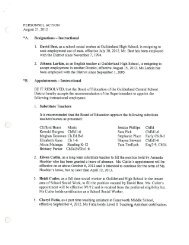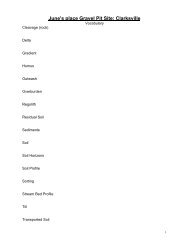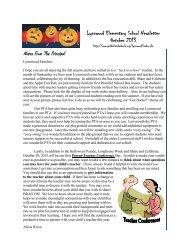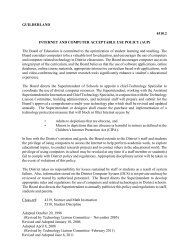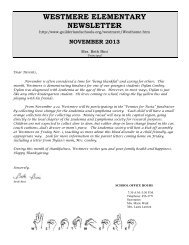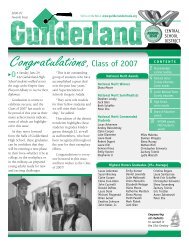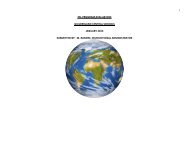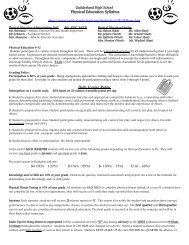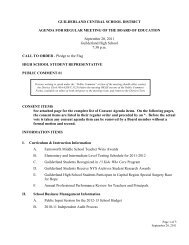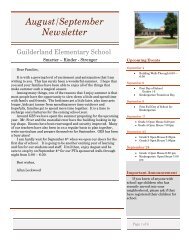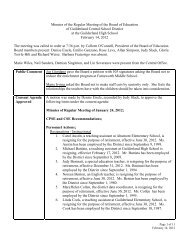How to Bring Our Schools Out of the 20th Century - Guilderland ...
How to Bring Our Schools Out of the 20th Century - Guilderland ...
How to Bring Our Schools Out of the 20th Century - Guilderland ...
You also want an ePaper? Increase the reach of your titles
YUMPU automatically turns print PDFs into web optimized ePapers that Google loves.
programs achieve outcomes that are consistent across grade levels.<br />
5. Curriculum<br />
Human, fiscal and time resources are available for systematic curriculum<br />
development. The curriculum review cycle provides for assessment.<br />
6. Instruction<br />
Will be appropriate <strong>to</strong> <strong>the</strong> developmental level <strong>of</strong> <strong>the</strong> students and consistent with<br />
program outcomes and current pr<strong>of</strong>essional practices.<br />
7. Materials<br />
Materials appropriate for students’ developmental level, rich in au<strong>the</strong>ntic culture<br />
and language, and related <strong>to</strong> <strong>the</strong> curriculum are key components in elementary<br />
school foreign language programs. The main focus <strong>of</strong> all materials, both print and<br />
non-print, is <strong>the</strong> teaching <strong>of</strong> communication.<br />
8. Evaluation<br />
Processes for evaluating both student pr<strong>of</strong>iciency and program success are in use.<br />
Evaluation processes are appropriate <strong>to</strong> <strong>the</strong> goals, objectives, and teaching strategies<br />
<strong>of</strong> elementary school foreign language programs, as well as <strong>to</strong> <strong>the</strong> developmental<br />
level <strong>of</strong> children.<br />
9. Staffing<br />
Programs are staffed by certified teachers who have completed preparation in<br />
methods and materials for elementary school foreign language instruction,<br />
developmental characteristics <strong>of</strong> <strong>the</strong> elementary school learner, and <strong>the</strong> nature <strong>of</strong> <strong>the</strong><br />
elementary school curriculum. Modern foreign language teachers should have a<br />
high level <strong>of</strong> language and cultural competence.<br />
10. Pr<strong>of</strong>essional Development<br />
An ongoing program <strong>of</strong> pr<strong>of</strong>essional development should allow teachers <strong>to</strong> advance<br />
in <strong>the</strong>ir levels <strong>of</strong> language, culture, and instruction.<br />
11. School and Community Support and Development<br />
The foreign language teachers work with <strong>the</strong> entire school community <strong>to</strong> integrate<br />
<strong>the</strong> foreign language curriculum in<strong>to</strong> <strong>the</strong> school educational program. The<br />
elementary school foreign language program shows responsibility for and makes<br />
effective use <strong>of</strong> parent and community resources and <strong>of</strong> school board and<br />
administrative staff.<br />
12. Culture<br />
The connection between language and culture is made explicit, and foreign<br />
language instruction is implemented within a cultural context. Cultural awareness<br />
and understanding are explicit goals <strong>of</strong> <strong>the</strong> program. The program collaborates with<br />
o<strong>the</strong>r cultures and countries (exchange programs, pen pals, etc.) <strong>to</strong> assure language<br />
learning within a context <strong>of</strong> cultural experiences. We believe <strong>the</strong> emphasis on<br />
cultural understanding fits very well with our bullying prevention efforts.<br />
6



